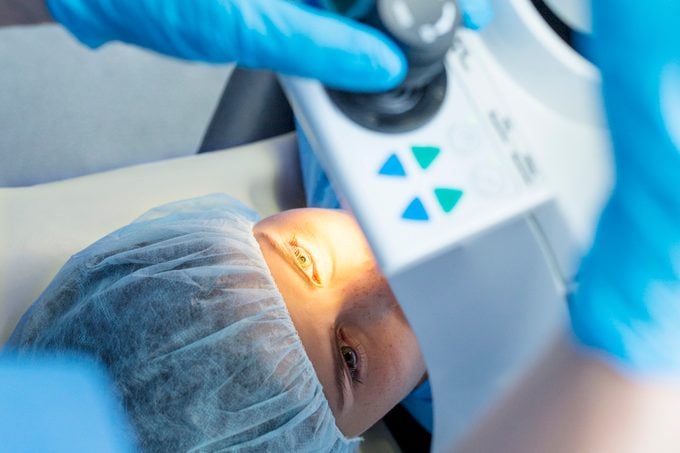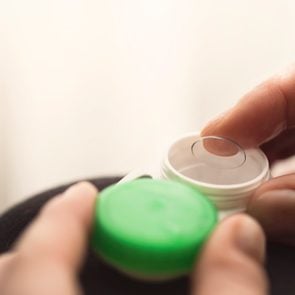PRK vs. LASIK: Which Eye Procedure Should You Get?
Updated: Mar. 14, 2022
Thinking about getting PRK or LASIK eye surgery? Here's what you should know about each one before you ditch your eyeglasses and contact lenses for good.
What are PRK and LASIK?
You may never have to decipher another glasses or contacts prescription if you opt for PRK or LASIK surgery.
According to the American Academy of Ophthalmology, nine out of 10 people who get PRK or LASIK come away with 20/20 or 20/40 vision without wearing eyeglasses or contacts.
These surgeries improve or correct refractive errors, a common vision condition in which the shape of your eye does not bend light correctly, which leads to blurry vision. Refractive errors include myopia (nearsightedness), hyperopia (farsightedness), or astigmatism. Many people treat these vision problems with eyeglasses or contact lenses, while others prefer to get surgery.
Here’s what you need to know about each procedure.

What’s the difference between PRK and LASIK?
Both procedures use lasers to correct your eye’s focusing ability by reshaping the cornea. PRK is short for “photorefractive keratectomy,” and it’s the oldest of the two procedures, created in 1948 by ophthalmologist Jose I. Barraquer Moner.
LASIK is short for “laser-assisted in situ keratomileusis.” Interestingly enough, “keratomileusis” literally means “sculpting” of the “cornea.”
Yes, that sounds like a frightening and painful procedure, but it isn’t. You won’t feel a thing (with either surgery), as your doctor administers numbing drops, and if you’re still nervous, a mild sedative can help with surgery jitters.
The main difference between PRK and LASIK is the actual procedure, but there are other things to consider, such as recovery and healing time, post-op pain, and pre-existing conditions. Here’s a breakdown of PRK and LASIK.
How is PRK done?
Thankfully, the surgery is fairly quick, usually just 15 minutes. But first, you’ll get antibiotic eye drops, and eye drops to numb the pain. Many patients also opt for a mild sedative to help them relax.
Your ophthalmologist will place an eyelid holder on your eye to keep it from blinking. Then the ophthalmologist will gently remove the outer layer of cells on your cornea, called the epithelium, to allow access for a laser to reshape your cornea.
Next, your ophthalmologist reshapes your cornea using a laser. Don’t worry— the surgeon isn’t freestyling this part. The laser is programmed with specific measurements for your eye.
The outer layers of the cornea actually regenerate and repair themselves naturally during the recovery process.
PRK recovery
PRK recovery time is longer than LASIK and could be disruptive to your regular routine for a while. For the best results, be sure to follow all post-operative instructions to the letter. A “bandage” contact lens helps speed the healing.
Most patients don’t have much pain for the first 36 to 48 hours following surgery, but many will feel some mild to moderate pain afterward that may last a day or two. Ibuprofen or acetaminophen and ice gel packs treat mild pain, but your doctor can prescribe something stronger for breakthrough pain.
You’ll need a ride home after the surgery and shouldn’t drive for the first week. You’ll probably have to use antibiotic eye drops for four to seven days and topical steroids for a number of weeks to several months, depending on the healing process.
Avoid visually demanding tasks for a few days, and keep water and makeup away from your eyes for the first week of recovery. Consider yourself “benched” for all strenuous activities, contact sports, and swimming for several weeks.
“It is also important to wear ultraviolet eye protection sunglasses while outside after PRK surgery,” advises Edward Manche, MD, an ophthalmologist, and professor of ophthalmology at Stanford University.
“UV irradiation can cause corneal haze (a form of scarring), especially in the early post-operative period of several weeks to first several months.”
Why is recovery longer for PRK than for LASIK?
In PRK, the superficial surface cells of the central cornea are removed, exposing underlying nerves in the cornea. “The cornea is one of the most densely innervated organs in the human body,” Dr. Manche says.
“This is why there is significant pain in the early post-operative course.” The superficial cells in the cornea are composed of five layers of the epithelium.
The cells are generated in the limbus (where the white meets the colored part of the eye). They begin to migrate from the limbus to cover the exposed central cornea. But it’s a slow process. Each layer takes about two to four days to cover the central cornea area. In about two to three weeks, the layers are complete.
“The cells then smooth out over the next several weeks and form a smooth cornea, which enables the patients to see clearly without glasses and contact lenses,” Dr. Manche says.
Vision after PRK
It’s normal to have blurry vision in the first few days following surgery, and you’ll make progress over a few weeks and likely achieve good vision in four to eight weeks after PRK, Dr. Manche says. PRK doesn’t fix presbyopia, so hang on to your drugstore reading glasses.

PRK risks and complications
First, the good news: “PRK actually has less risk than LASIK, because once the outer layer of the cornea heals after the procedure, there is little risk of further problems,” says Nathan Hamburger, MD, an ophthalmologist in Steamboat Springs, Colorado, and at the UCHealth Yampa Valley Medical Center.
Still, all surgeries carry risks and complications. Side effects and complications you should know about include:
- increased risk of eye infection
- cloudiness of the cornea
- scarring of the cornea
- halos and glares around lights, mostly at night
There is also an increased risk of developing dry eyes immediately or as an ongoing condition. When the cornea is resurfaced or recontoured during surgery, corneal nerve damage and/or loss of corneal nerves can cause dry eyes. That’s something to think about if you rub your eyes a lot when seasonal allergies hit, as PRK (or LASIK) can make dry eyes worse.
Post-surgery vision may be undercorrected or overcorrected, requiring additional surgery, contact lenses, or laser surgery.
Having worse vision (even while wearing eyeglasses or contacts after surgery) or blindness is possible, but these complications are very rare.
How is LASIK done?
LASIK follows the same surgery prep as PRK, and is also a quick procedure of about 15 minutes.
The primary difference is the formation of a flap. Instead of removing the cornea’s outer layer as with PRK, the ophthalmologist forms a flap on the outer cornea to reshape the cornea. A precision laser creates a paper-thin hinged flap on the surface of the cornea. While you’re focused on a light above, the ophthalmologist lifts and folds back the flap to reshape the cornea using a laser. Once the cornea is treated, the flap is realigned and smoothed out. It attaches on its own in just a couple of minutes, where it will heal in place.
Is LASIK recovery painful?
“LASIK patients experience little discomfort,” Dr. Hamburger says. And LASIK recovery is quicker than PRK recovery.
You’ll still need someone to drive you home, and your doctor might send you home wearing a clear shield over your eyes to help protect them. Though there usually isn’t much pain, your eyes may burn or feel a bit scratchy, but you’ll have eye drops and pain medication to soothe your eyes.
Generally, most patients take it easy for the rest of the day and return to work or other activities the following day. Still, doctors recommend avoiding strenuous activity or visually demanding tasks following your procedure for a couple of days.
Vision after LASIK
LASIK surgery restores vision a lot faster than PRK. “Patients can expect visual recovery in as little as 24 hours,” Dr. Hamburger says. That means immediate vision improvement, but probably not fully restored sight right away, especially if you had hyperopia (farsightedness).
In that case, recovery usually takes two to three weeks, and in rare cases, it might take up to three months for vision to be fully restored. As with PRK, LASIK doesn’t correct age-related presbyopia. Here’s how to keep your new peepers in tip-top shape.
LASIK risks and complications
Here’s where that flap comes into play again. It’s great for a speedier recovery over PRK, but it has some potential to cause problems down the road. “There is always a risk of future trauma that could disrupt the LASIK flap,” Dr. Hamburger says.
In rare cases, vision-threatening, flap-related complications can occur, notes James Murphy, MD, an ophthalmologist at ReFocus in Branford and Hamden, Connecticut.
For example, epithelial downgrowth develops when the epithelial cells invade the eye. A condition known as ectasia of the cornea can cause permanent damage to the eye if too much tissue is taken from the cornea. And inflammation of the cornea may occur as a complication.
“Treating these conditions ranges from using eye drops to needing an additional procedure to possibly requiring a specialized contact lens for permanently poor vision that is difficult to fully correct,” Dr. Murphy says.
More common complications and side effects that may be temporary or long-term include:
- dry eyes and changing vision during the day for the first month
- eye discomfort or pain
- blurry, foggy, or hazy vision
- scratchy eyes
- halos or glares around lights, especially at night
- sensitivity to light
- bloodshot eyes
- eye infection
- worse vision after LASIK, even while wearing glasses or contact lenses
- uncorrected or overcorrected vision after surgery, resulting in additional laser surgery, eyeglasses, or contact lenses
Am I a good candidate for PRK or LASIK?

Just about anyone who is a candidate for LASIK is also a candidate for PRK. However, the current state of your cornea helps your doctor decide if refractive surgery is a good fit.
“Patients with a history of corneal diseases or certain corneal infections, history of abnormal scarring, dry eye or certain autoimmune conditions may not be good candidates for PRK or LASIK,” Dr. Hamburger says. And nearsighted patients must have a steep enough cornea curvature so the cornea is not too flat after treatment.
While the state of your cornea is one of the main concerns, it isn’t the only factor when considering surgery. “It is important to address underlying conditions affecting the ocular surface and cornea before proceeding with laser vision correction, so these conditions are not exacerbated or worsened by the procedures,” Dr. Murphy says.
Let’s not forget your lifestyle. PRK is often recommended for people who play high-contact sports or have high-risk jobs, where eye injuries are more common than in desk jobs, because there is no flap and thus no potential for flap complications.
How long do PRK and LASIK last?
PRK and LASIK surgery both permanently correct the vision prescription you have at the time of the procedure. But some patients’ myopia or hyperopia can progress. Also, eyesight naturally changes during certain life stages such as pregnancy and menopause, and in people older than 60 years.
Depending on your age and other eye health conditions such as cataracts, additional surgery or a “refresher” may be needed. Or you may opt to correct slight vision issues with eyeglasses or contacts. Either way, your vision will probably never be as bad as it was prior to your first procedure.
PRK and LASIK costs
Unfortunately, PRK and LASIK are elective procedures, so insurance rarely covers them. Costs vary from surgeon to surgeon, clinic to clinic, and state to state. However, LASIK is generally more expensive than PRK (but not always), ranging from $1,000 to $2,000 per eye, Dr. Murphy says. So why is the cost of LASIK usually higher?
“The cost difference relates to more convenience with returning to daily life, work, etc.,” Dr. Murphy says. LASIK is essentially 20/20 vision within minutes after surgery, and PRK typically has discomfort, post-op precautions, and a longer time to achieve restored vision.
If PRK or LASIK is right for you, it might be a smart way to spend the last of your flexible spending account money.



